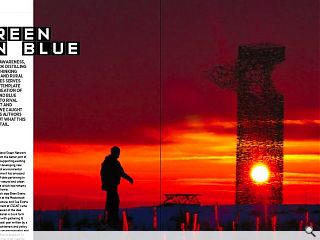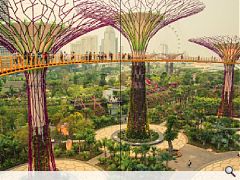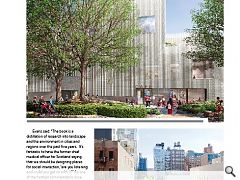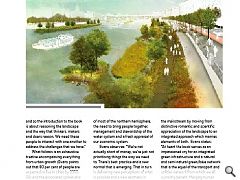Growing Awareness: Green on Blue
6 Jul 2016
Growing Awareness, a new book distilling current thinking on urban and rural landscapes serves as a bold template for the creation of a green and blue network to rival transport and utilities. We caught up with its authors to find out what this would entail.
The Central Scotland Green Network (CSGNT) has spent the better part of the past decade supporting existing partnerships and developing new ones in the field of environmental policy, in which time it has amassed a broad sweep of data pertaining to our natural, semi-natural and urban environments but which has hitherto lacked a concise home.Into the breach step Brian Evans, head of urbanism at the Mackintosh School of Architecture, and Sue Evans, head of development at CSGNT) who having first conceived of the idea to collate this material in book form were duly tasked with gathering 15 essays over the past year written by a who’s who of practitioners and policy makers including environmentalist and writer Jonathon Porritt and prof Sir Harry Burns, a former chief medical officer for Scotland.
Evans said: “The book is a distillation of research into landscape and the environment in cities and regions over the past five years. It’s fantastic to have the former chief medical officer for Scotland saying that we should be designing places for social interaction, ‘are you listening and could you get on with it?’ As one of the football commentators once said, ‘nectar to my ears’!”
The resulting book is gathered together in three sections; learning from thought, learning from place and learning from action to show how awareness of green issues can feed through into evolving perceptions of ideas and places.
“Everybody thinks about what they do but my colleague prof Vicky Gunn made the point that people reason about things in a different way and so the introduction to the book is about reasoning the landscape and the way that thinkers, makers and doers reason. We need these people to interact with one another to address the challenges that we have.”
What follows is an exhaustive treatise encompassing everything from urban growth (Evans points out that 80 per cent of people are expected to live in cities by 2030-50) and the associated sprawl and challenges to existing eco systems such migrations entail.
Rattling off just some of the themes which come in for scrutiny Evans reels off a list of doom-laden issues with which the world is still grappling and yet to form answers including effects borne out of climate change such as extreme weather, drought and heat islands to the loss of biodiversity. Evans also raises the issue of health, the de-industrialisation of most of the northern hemisphere, the need to bring people together, management and stewardship of the water system and a fresh appraisal of our economic system.
Evans observes: “We’re not actually short of money, we’re just not prioritising things the way we need to. There’s best practice and a new normal that is emerging. That in turn is delivering new perceptions of what is possible and a new aesthetic in landscape. We used to reflect on the landscape as sublime, we approached it with awe. The landscape was awe inspiring to the Georgians then we moved through the picturesque, the gardenesque where landscape was manicured and now we have re-wilded the landscape by bringing wildness back into the city in a biophilic landscape.”
The book concludes with talk of transferring such ideas into the mainstream by moving from distinctive romantic and scientific appreciation of the landscape to an integrated approach which marries elements of both. Evans states: “At heart the book serves as an impassioned cry for an integrated green infrastructure and a natural and semi natural green/blue network that is the equal of the transport and utilities network from which we all currently benefit. Merging human habitats with nature to create elegant viable, resilient places that create social cohesion and integration all bound up within Burns’ concept of wellness.”
As the challenges described in Growing Awareness themselves grow the need to carve out a proper policy and practical responses grows with it. Hopefully this work can go some way toward bringing about solutions for tomorrow’s environment.
|
|
Read next: Perth: City Sicker?
Read previous: Brexit: Referendone
Back to July 2016
Browse Features Archive
Search
News
For more news from the industry visit our News section.
Features & Reports
For more information from the industry visit our Features & Reports section.






